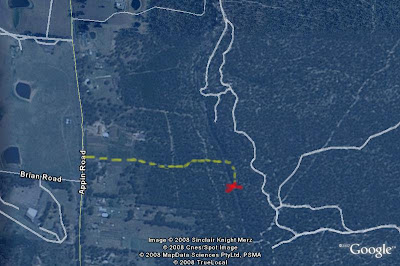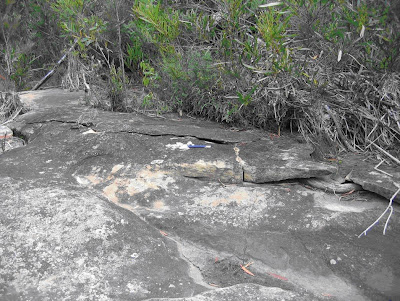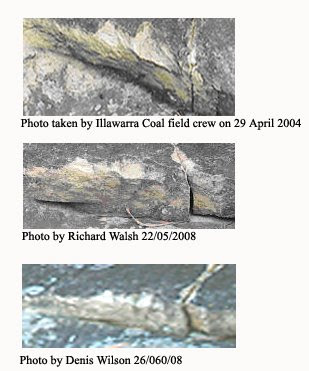Anyway, this is what Caroline had sent out to the Media:
"Georges River Cracked by Longwall Mining "
"On 25th June, Denis Wilson of the Save Water Alliance and myself inspected the Upper Georges River near Appin for damage caused by BHP Billiton's latest longwall mines, which were allowed to go right up to the river bank. Attached are my photos of cracking which we discovered. Mining is continuing along the river in this area.
"We want to alert the people of NSW to the ongoing and irreparable damage being done to our rivers, creeks, wetlands and aquifers by mining, thanks to approvals handed to the mining companies by the Iemma Government."
Since then, BHP Billiton has been onto Caroline asking her to withdraw her allegations that the cracking was caused by mine subsidence. They did this on the basis that they apparently had photographic evidence that the crack was there in 2004. This is their photo:
Well, I sent Dave Burgess an email with a Google Earth image, locating where we had been.
 He has come back, advising where we were in relation to the BHP Billiton longwalls. He said:
He has come back, advising where we were in relation to the BHP Billiton longwalls. He said:"You were at the end of LW31. So if that photo is from 2004 (LW29 was mined in 2003/04) the
crack extends from mining about 300m away."
Here is another BHP Billiton photo - taken by Richard Walsh on 22 May 2008. What I noticed straight away, when I saw it was that the crack in the rock is considerably larger in 2008 than it apparently was in 2004.
So how does that help their case?
 Here I have pasted together 3 different images of the crack, with dates, as provided by BHP and then my own photo (with date from my records).
Here I have pasted together 3 different images of the crack, with dates, as provided by BHP and then my own photo (with date from my records). The other thing I notice is that they have concentrated on the near edge of the crack, but the reality is that a whole rock shelf has cracked. It is difficult to judge, but I estimate the length of the crack to be about 3 to 4 metres in length (it extends past Caroline's feet).
The other thing I notice is that they have concentrated on the near edge of the crack, but the reality is that a whole rock shelf has cracked. It is difficult to judge, but I estimate the length of the crack to be about 3 to 4 metres in length (it extends past Caroline's feet). And, as a well, they have the nerve to suggest that the rock has (possibly) been cracked by the root which is visible on the right hand edge. They say: "The final photograph is one which we took in May this year which may give you some insight into the cause of the cracking (note the tree root under the rock).
And, as a well, they have the nerve to suggest that the rock has (possibly) been cracked by the root which is visible on the right hand edge. They say: "The final photograph is one which we took in May this year which may give you some insight into the cause of the cracking (note the tree root under the rock).I would simply point out that, as illustrated in my post of 25 June 2008, BHP Billiton have installed a series of hi-tech Survey Monitoring points, which they use to monitor "valley closure". Why would they do that, if they think that the cracking is caused by tree roots?
Gee, I wish I could get paid well by a Multi-National Company to come up with lame excuses like that!


No comments:
Post a Comment